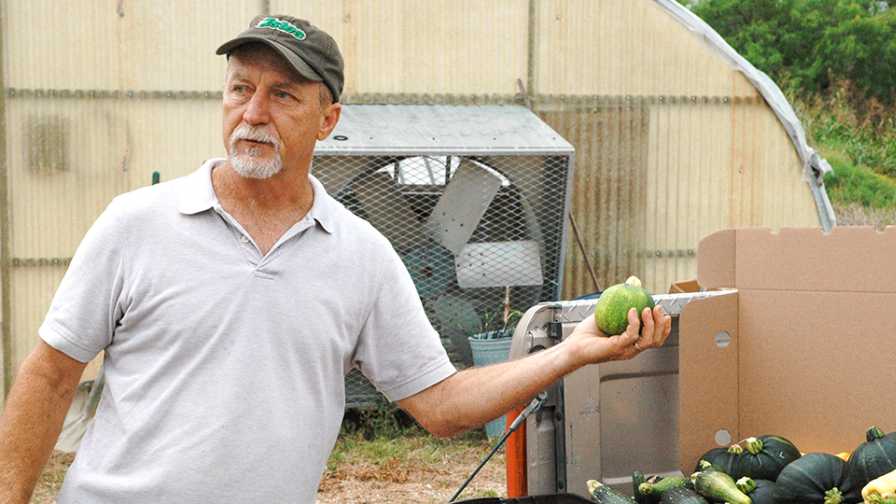Why Responsive Agriculture Offers the Nutrition Advantage

David Anderson, a hydroponic producer, showcases some of his produce in Marion, TX.
Photo by Paul Schattenberg
Consumers expect more from their food these days. And that gives food producers profitable opportunities to capitalize on trends.
Previously, the aim of agriculture and America’s food system was to provide consumers with food, fiber, and fuel. But consumer priorities have evolved.
Today, consumers expect a variety of options, including food that promotes human health, ensures the smallest environmental footprint, is economically sustainable, and meets the needs of a growing human population. It needs to do all this while delivering its most basic function: preventing hunger.
Health solutions, abundant choices, varied preferences, and food trends all allow producers new opportunities for farmers and ranchers to meet the needs of markets and to lower diet-related health care costs, which are crippling economies globally.
Sound Science Leads the Way
As we enter a new decade, we’re no longer talking about food; we’re talking about nutrition. Consumer needs are more important than ever because, as we say at Texas A&M AgriLife, we aren’t just feeding the world, we’re nourishing the world as well.
That’s a lofty goal. After all, the environmental and economic sustainability of current agricultural practices is uncertain. The public now expects agriculture to decrease heath care costs, which, in turn, will require changes in dietary practices.
How do we reach those goals? It will require science-based solutions. Food system advocacy and personal preferences in all of its forms must take a back seat to sound, scientific evidence.
The public has been inundated for decades by alarming reports about the foods we eat and the diseases they cause. Diet-related chronic diseases have been estimated to cost the U.S. economy $1 trillion each year. Half of all adults in the U.S. receive treatment for a chronic disease.
Now is the time for responsive agriculture, where producers develop foods that enhance human health and increase agricultural profitability to sustainably secure the economic outlook. Rigorous science must lead the way if we are to better align human health and the food system.
Ag Can Boost Nutrition
As life scientists and agricultural scientists, we develop products that respond to community needs and consumer health, values, and preferences. This results in crops, feeds, and other products with higher value, higher yield potential, lower environmental footprint, enhanced nutritional value, and greater resistance to drought, heat, and disease.
We are action-oriented, and we support the health and preferences of consumers, the environment, and producers with science-based solutions.
AgriLife research on sorghum is known for developing sorghum varieties for animal feed and energy sectors. Now, cereal eaters across the nation are learning about the sorghum team’s contributions to healthier human foods. Leading the way on this research is Bill Rooney, Ph.D., AgriLife Research sorghum breeder and Borlaug-Monsanto Chair for Plant Breeding and International Crop Improvement in the Texas A&M University Department of Soil and Crop Sciences.
Our sorghum breeders specifically targeted the health food market when they developed the black grain sorghum hybrid Onyx in 2012. Onyx is an excellent example of how to enhance the nutritional quality of the food supply to help manage chronic diseases. The sorghum team aimed for greater product quality and human nutrition goals.
The new sorghum we developed is an all-natural grain based on ancient black and high-tannin sorghum varieties. These ancient varieties bring together in each plant a powerful combination of antioxidants that fight a wide spectrum of free-radical threats to our bodies. The Onyx hybrid was selected to meet the growing public interest in foods with high antioxidant capacity.
Onyx is not only good for consumers, but also for producers. A second variety we created, Onyx2, has the same components as the original but offers better yields. An issue with the original Onyx was that the yield potential was lower than that of commercial grain sorghum hybrids. We increased yields from the first to the second hybrid by about 25% — proof that research can help both producers and consumers.
What Do We Do Next?
Agriculture is at a crossroads. Expectations to nourish the growing world population while ensuring environmental and economic sustainability have never been higher, or the public spotlight brighter.
Surpassing consumer expectations of the food system is going to require sound science to direct policies and practices to ensure people’s health, a healthier planet, and a more sustainable agricultural system. Agriculture, food security, and population health are all fundamental to our future. Our goal is to ensure health by meeting nutrition demands through integrated research, as evidenced throughout the life sciences, social science, environmental science, policy, and economics.
Food system advocacy and scientific evidence are all too often disconnected, even within the academic community. Through scientific advancement, we must strengthen and help to ensure the public’s continued trust in all aspects of agriculture. It’s the healthiest way forward for Americans, our environment, and our economy. It is essential for our country as a whole. Our ability to nourish the planet and avoid hunger hang in the balance.
As people want to be more connected to their food, and demand more from it, we in agriculture have the opportunity to strengthen the connection from the farm to the table. As we enter this new decade, we can create foods that help prevent chronic disease while preventing hunger, and we can do it together.










